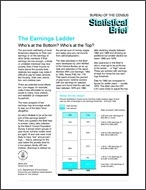
An official website of the United States government
Here’s how you know
Official websites use .gov
A .gov website belongs to an official government organization in the United States.
Secure .gov websites use HTTPS
A lock (
) or https:// means you’ve safely connected to the .gov website. Share sensitive information only on official, secure websites.
-
//
- Census.gov /
- Library /
- Publications /
- The Earnings Ladder: Who's at the Bottom? Who's at the Top?
Statistical Brief: The Earnings Ladder: Who's at the Bottom? Who's at the Top?
Statistical Brief: The Earnings Ladder: Who's at the Bottom? Who's at the Top?
The economic well-being of most Americans depends on their own earnings or on the earnings of other family members. If their earnings are low enough, a family or unrelated individual may face poverty. Even if their income remains above the poverty level, relatively low wages may make it difficult to pay for basic services, like housing, child care, education, and medical care.
There are potential social effects too. Low wages, for example, make it less affordable for young adults to marry, have children, and establish an independent household.
The mere prospect of low earnings may encourage adults to stay out of the labor force altogether.
So who’s likeliest to be at the bottom of this earnings ladder? That’s one question this Brief tries to answer. Using data collected by the March Current Population Survey, it shows which groups of year-round, full-time civilian workers aged 16 and over were most likely to have “low” annual earnings – that is, earnings for the year below the poverty level for a four-person family with two children. (Earnings is defined as the pre-tax sum of money wages and salary plus any net income from self-employment.)
The data described in this Brief were developed by John McNeil of the Census Bureau as an update and extension of his report, Workers With Low Earnings, 1964 to 1990, Series P60, No. 178. That report showed the percent of year-round, full-time workers with low earnings for selected years and found that the rate had risen between 1979 and 1990 after declining sharply between 1964 and 1969 and showing an additional but smaller decline between 1969 and 1979.
Also examined in this Brief is who’s most apt to be at the top of the ladder – a “high” earner. These are workers with earnings at least four times the low earnings threshold.
Data for 1992 are compared to figures for earlier years – usually 1979. This Brief uses the CPI-U-X1 price index to adjust the low earnings thresholds for price changes over time. The results in a 1992 low earnings threshold that is somewhat lower than the official poverty threshold ($14,228 for a four-person family with two children).
Others in Series
Publication
Publication
Publication
Share
Some content on this site is available in several different electronic formats. Some of the files may require a plug-in or additional software to view.
 Yes
Yes
 No
NoComments or suggestions?


Top

